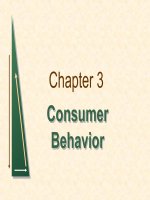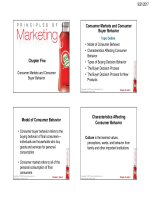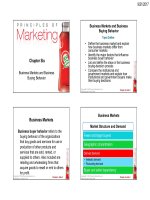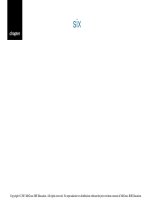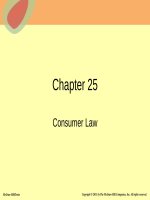Lecture Economics (19/e) - Chapter 6-App: Consumer behavior
Bạn đang xem bản rút gọn của tài liệu. Xem và tải ngay bản đầy đủ của tài liệu tại đây (301.9 KB, 10 trang )
06A
Appendix
Consumer Behavior
McGrawHill/Irwin
Copyright © 2012 by The McGrawHill Companies, Inc. All rights reserved.
The Budget Line: What is Attainable
• Combinations of two products a
•
•
•
LO6
consumer can purchase with their
money income
Slope is the ratio of the price of B to
the price of A
Location varies with income changes
Location varies with price of products
6App-2
The Budget Line
(Price = $1.50)
8
6
4
2
0
Total
(Price = $1)
Expenditure
0
3
6
9
12
$12
12
12
12
12
10
Quantity of A
Units of A Units of B
12
8
(Unattainable)
6
4
2
0
LO6
Income = $12
PA = $1.50
(Attainable)
2
4
6
Income = $12
PB = $1
8
Quantity of B
10
12
6App-3
Indifference Curves: What is Preferred
• Combinations of two products that
•
•
LO6
yield the same amount of total utility
The consumer is indifferent as to
which combination to purchase
Characteristics
• Downsloping
• Convex to the origin
• Reflects the MRS
6App-4
Indifference Curves
12
j
LO6
Quantity of A
10
8
j
12
2
k
6
4
l
4
6
2
m
3
8
0
k
6
l
m
4
I
2
4
6
8
Quantity of B
10
12
6App-5
The Indifference Map
• Series of indifference curves where
•
LO6
each curve reflects different amounts
of utility
Each successive curve outward
reflects a higher level of utility
6App-6
The Indifference Map
12
Quantity of A
10
8
6
4
I4
2
I3
I1
0
2
LO6
4
I2
6
8
10 12
Quantity of B
6App-7
Equilibrium at Tangency
• The consumer’s equilibrium position
• Indifference curve is tangent to the
budget line
• Utility is maximized
• MRS equals the ratio of the price of
B to the price of A
LO6
6App-8
Equilibrium at Tangency
12
Quantity of A
10
PB
MRS =
PA
8
6
W
X
4
Preferred –
but requires
more income
I4
2
0
LO6
I3
I1
2
4
6
8
Quantity of B
10
I2
12
6App-9
Derivation of the Demand Curve
12
Quantity of A
10
8
6
X
4
2
I2
Price of B
0
2
4
6
8
10
Quantity of B
I3
12
$1.50
1.00
.50
DB
2
LO6
4
6
8
10
Quantity of B
12
6App-10
